Food Safety Management Report: Food Safety and Hygiene Measures
VerifiedAdded on 2020/06/06
|12
|3340
|412
Report
AI Summary
This report provides a comprehensive overview of food safety management, encompassing various aspects crucial for ensuring food safety and hygiene. It begins by discussing the controls required to prevent food contamination, differentiating between physical and chemical contamination and highlighting the importance of personal hygiene. The report then delves into the characteristics of food poisoning and food-borne infections, explaining how these illnesses can be controlled through proper cleaning, washing, and handling of food. Furthermore, it explores food-spoilage agents, including water content, environmental factors, and packaging, and examines various methods of food preservation such as fermentation, home canning, and refrigeration, along with their effectiveness. The report also outlines the steps in a temperature control system, summarizing methods for safe food storage and emphasizing the significance of personal hygiene in preventing contamination. Additionally, it evaluates cleaning and disinfection practices, assesses problems associated with pest control, and justifies the importance of hygienic design and construction in food premises, concluding with the significance of training as a quality assurance mechanism. The report also provides insights into producing food hazard risk assessments, and food safety control systems, and offers guidance on food safety for compliance with legislation.

Food Safety Management
Paraphrase This Document
Need a fresh take? Get an instant paraphrase of this document with our AI Paraphraser

TABLE OF CONTENTS
INTRODUCTION...........................................................................................................................1
TASK 1............................................................................................................................................1
1.1 Discussing controls required to prevent contamination of food.......................................1
1.2 Characteristics of food poisoning and food-borne infections...........................................1
1.3 How food-borne illnesses can be controlled....................................................................2
TASK 2 ...........................................................................................................................................2
2.1 Discussing food-spoilage agents......................................................................................2
2.2 Explaining methods of food preservation and 2.3 Effectiveness of food preservation
methods...................................................................................................................................3
TASK 3............................................................................................................................................4
3.1 Steps in temperature control system.................................................................................4
3.2 Summarizing methods for safe storage of food................................................................4
3.3 Significance of personal hygiene in preventing food contamination...............................5
3.4 Evaluating cleaning and disinfection for ensuring food safety........................................5
3.5 Assessment of problems associated with pest control......................................................5
3.6 Justification of hygienic design and construction in food premises.................................6
3.7 Significance of training as a quality assurance mechanism.............................................6
4.1 Producing food hazard risk assessment............................................................................6
4.2 Producing food safety control system..............................................................................7
4.3 Food safety guide for compliance with legislation...........................................................8
CONCLUSION................................................................................................................................8
REFERENCES................................................................................................................................9
INTRODUCTION...........................................................................................................................1
TASK 1............................................................................................................................................1
1.1 Discussing controls required to prevent contamination of food.......................................1
1.2 Characteristics of food poisoning and food-borne infections...........................................1
1.3 How food-borne illnesses can be controlled....................................................................2
TASK 2 ...........................................................................................................................................2
2.1 Discussing food-spoilage agents......................................................................................2
2.2 Explaining methods of food preservation and 2.3 Effectiveness of food preservation
methods...................................................................................................................................3
TASK 3............................................................................................................................................4
3.1 Steps in temperature control system.................................................................................4
3.2 Summarizing methods for safe storage of food................................................................4
3.3 Significance of personal hygiene in preventing food contamination...............................5
3.4 Evaluating cleaning and disinfection for ensuring food safety........................................5
3.5 Assessment of problems associated with pest control......................................................5
3.6 Justification of hygienic design and construction in food premises.................................6
3.7 Significance of training as a quality assurance mechanism.............................................6
4.1 Producing food hazard risk assessment............................................................................6
4.2 Producing food safety control system..............................................................................7
4.3 Food safety guide for compliance with legislation...........................................................8
CONCLUSION................................................................................................................................8
REFERENCES................................................................................................................................9
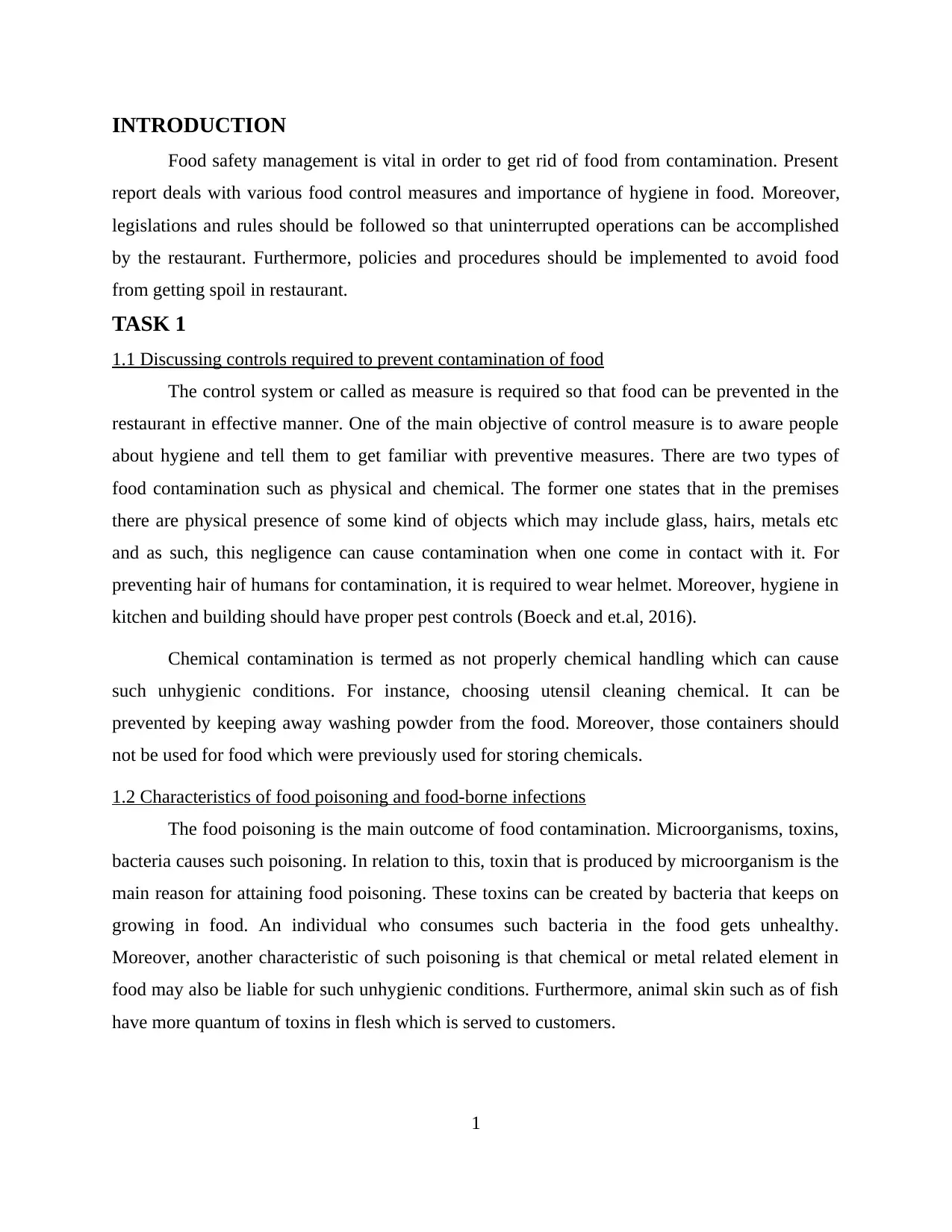
INTRODUCTION
Food safety management is vital in order to get rid of food from contamination. Present
report deals with various food control measures and importance of hygiene in food. Moreover,
legislations and rules should be followed so that uninterrupted operations can be accomplished
by the restaurant. Furthermore, policies and procedures should be implemented to avoid food
from getting spoil in restaurant.
TASK 1
1.1 Discussing controls required to prevent contamination of food
The control system or called as measure is required so that food can be prevented in the
restaurant in effective manner. One of the main objective of control measure is to aware people
about hygiene and tell them to get familiar with preventive measures. There are two types of
food contamination such as physical and chemical. The former one states that in the premises
there are physical presence of some kind of objects which may include glass, hairs, metals etc
and as such, this negligence can cause contamination when one come in contact with it. For
preventing hair of humans for contamination, it is required to wear helmet. Moreover, hygiene in
kitchen and building should have proper pest controls (Boeck and et.al, 2016).
Chemical contamination is termed as not properly chemical handling which can cause
such unhygienic conditions. For instance, choosing utensil cleaning chemical. It can be
prevented by keeping away washing powder from the food. Moreover, those containers should
not be used for food which were previously used for storing chemicals.
1.2 Characteristics of food poisoning and food-borne infections
The food poisoning is the main outcome of food contamination. Microorganisms, toxins,
bacteria causes such poisoning. In relation to this, toxin that is produced by microorganism is the
main reason for attaining food poisoning. These toxins can be created by bacteria that keeps on
growing in food. An individual who consumes such bacteria in the food gets unhealthy.
Moreover, another characteristic of such poisoning is that chemical or metal related element in
food may also be liable for such unhygienic conditions. Furthermore, animal skin such as of fish
have more quantum of toxins in flesh which is served to customers.
1
Food safety management is vital in order to get rid of food from contamination. Present
report deals with various food control measures and importance of hygiene in food. Moreover,
legislations and rules should be followed so that uninterrupted operations can be accomplished
by the restaurant. Furthermore, policies and procedures should be implemented to avoid food
from getting spoil in restaurant.
TASK 1
1.1 Discussing controls required to prevent contamination of food
The control system or called as measure is required so that food can be prevented in the
restaurant in effective manner. One of the main objective of control measure is to aware people
about hygiene and tell them to get familiar with preventive measures. There are two types of
food contamination such as physical and chemical. The former one states that in the premises
there are physical presence of some kind of objects which may include glass, hairs, metals etc
and as such, this negligence can cause contamination when one come in contact with it. For
preventing hair of humans for contamination, it is required to wear helmet. Moreover, hygiene in
kitchen and building should have proper pest controls (Boeck and et.al, 2016).
Chemical contamination is termed as not properly chemical handling which can cause
such unhygienic conditions. For instance, choosing utensil cleaning chemical. It can be
prevented by keeping away washing powder from the food. Moreover, those containers should
not be used for food which were previously used for storing chemicals.
1.2 Characteristics of food poisoning and food-borne infections
The food poisoning is the main outcome of food contamination. Microorganisms, toxins,
bacteria causes such poisoning. In relation to this, toxin that is produced by microorganism is the
main reason for attaining food poisoning. These toxins can be created by bacteria that keeps on
growing in food. An individual who consumes such bacteria in the food gets unhealthy.
Moreover, another characteristic of such poisoning is that chemical or metal related element in
food may also be liable for such unhygienic conditions. Furthermore, animal skin such as of fish
have more quantum of toxins in flesh which is served to customers.
1
⊘ This is a preview!⊘
Do you want full access?
Subscribe today to unlock all pages.

Trusted by 1+ million students worldwide
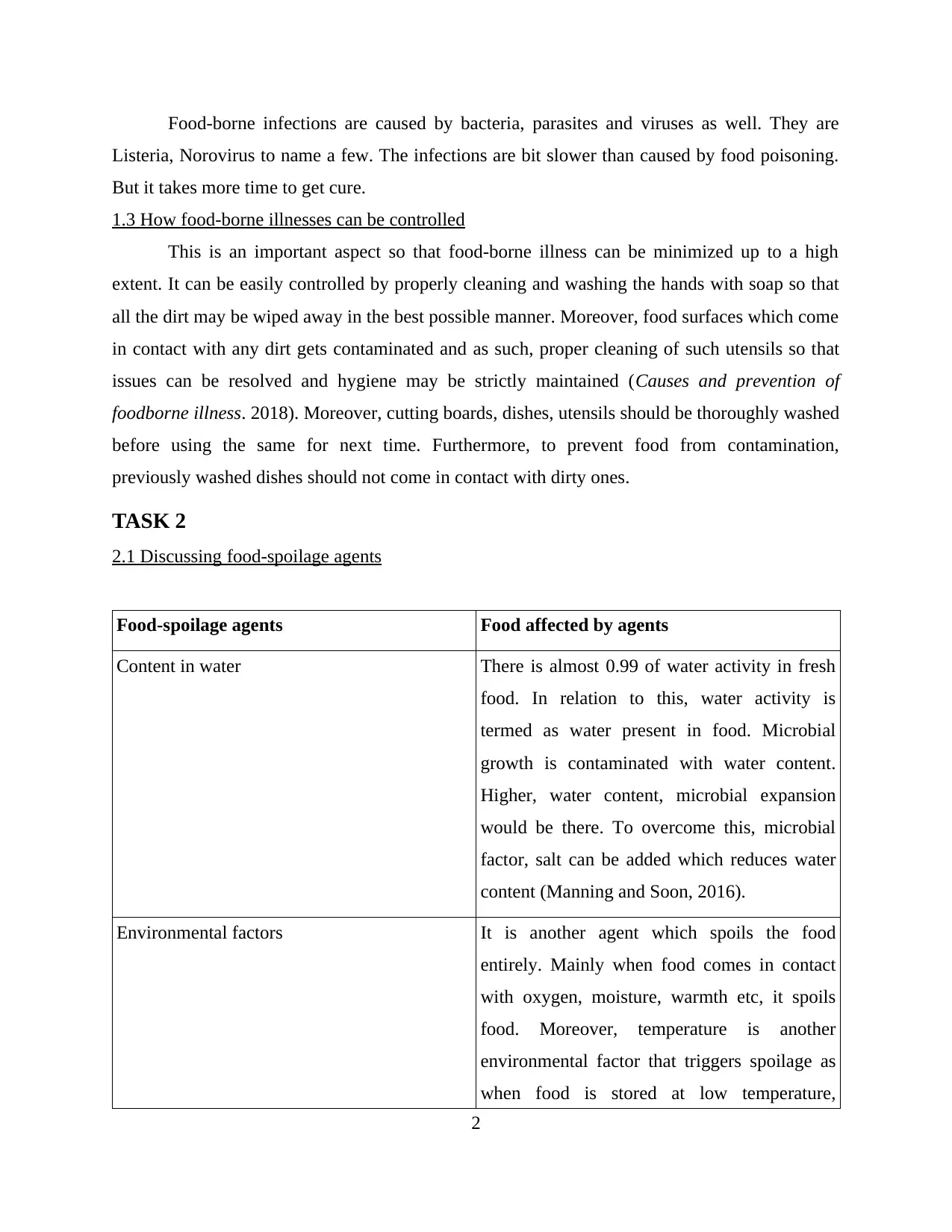
Food-borne infections are caused by bacteria, parasites and viruses as well. They are
Listeria, Norovirus to name a few. The infections are bit slower than caused by food poisoning.
But it takes more time to get cure.
1.3 How food-borne illnesses can be controlled
This is an important aspect so that food-borne illness can be minimized up to a high
extent. It can be easily controlled by properly cleaning and washing the hands with soap so that
all the dirt may be wiped away in the best possible manner. Moreover, food surfaces which come
in contact with any dirt gets contaminated and as such, proper cleaning of such utensils so that
issues can be resolved and hygiene may be strictly maintained (Causes and prevention of
foodborne illness. 2018). Moreover, cutting boards, dishes, utensils should be thoroughly washed
before using the same for next time. Furthermore, to prevent food from contamination,
previously washed dishes should not come in contact with dirty ones.
TASK 2
2.1 Discussing food-spoilage agents
Food-spoilage agents Food affected by agents
Content in water There is almost 0.99 of water activity in fresh
food. In relation to this, water activity is
termed as water present in food. Microbial
growth is contaminated with water content.
Higher, water content, microbial expansion
would be there. To overcome this, microbial
factor, salt can be added which reduces water
content (Manning and Soon, 2016).
Environmental factors It is another agent which spoils the food
entirely. Mainly when food comes in contact
with oxygen, moisture, warmth etc, it spoils
food. Moreover, temperature is another
environmental factor that triggers spoilage as
when food is stored at low temperature,
2
Listeria, Norovirus to name a few. The infections are bit slower than caused by food poisoning.
But it takes more time to get cure.
1.3 How food-borne illnesses can be controlled
This is an important aspect so that food-borne illness can be minimized up to a high
extent. It can be easily controlled by properly cleaning and washing the hands with soap so that
all the dirt may be wiped away in the best possible manner. Moreover, food surfaces which come
in contact with any dirt gets contaminated and as such, proper cleaning of such utensils so that
issues can be resolved and hygiene may be strictly maintained (Causes and prevention of
foodborne illness. 2018). Moreover, cutting boards, dishes, utensils should be thoroughly washed
before using the same for next time. Furthermore, to prevent food from contamination,
previously washed dishes should not come in contact with dirty ones.
TASK 2
2.1 Discussing food-spoilage agents
Food-spoilage agents Food affected by agents
Content in water There is almost 0.99 of water activity in fresh
food. In relation to this, water activity is
termed as water present in food. Microbial
growth is contaminated with water content.
Higher, water content, microbial expansion
would be there. To overcome this, microbial
factor, salt can be added which reduces water
content (Manning and Soon, 2016).
Environmental factors It is another agent which spoils the food
entirely. Mainly when food comes in contact
with oxygen, moisture, warmth etc, it spoils
food. Moreover, temperature is another
environmental factor that triggers spoilage as
when food is stored at low temperature,
2
Paraphrase This Document
Need a fresh take? Get an instant paraphrase of this document with our AI Paraphraser
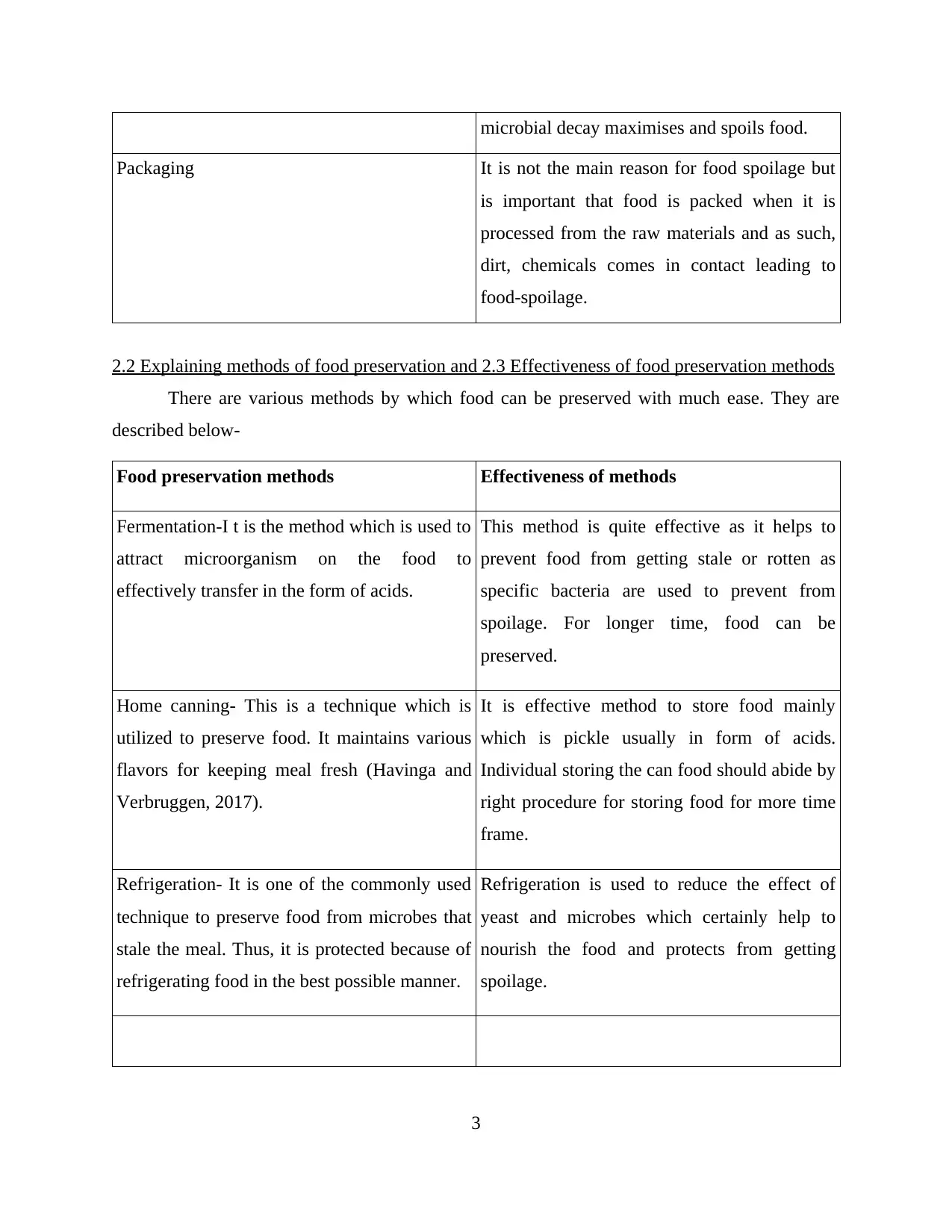
microbial decay maximises and spoils food.
Packaging It is not the main reason for food spoilage but
is important that food is packed when it is
processed from the raw materials and as such,
dirt, chemicals comes in contact leading to
food-spoilage.
2.2 Explaining methods of food preservation and 2.3 Effectiveness of food preservation methods
There are various methods by which food can be preserved with much ease. They are
described below-
Food preservation methods Effectiveness of methods
Fermentation-I t is the method which is used to
attract microorganism on the food to
effectively transfer in the form of acids.
This method is quite effective as it helps to
prevent food from getting stale or rotten as
specific bacteria are used to prevent from
spoilage. For longer time, food can be
preserved.
Home canning- This is a technique which is
utilized to preserve food. It maintains various
flavors for keeping meal fresh (Havinga and
Verbruggen, 2017).
It is effective method to store food mainly
which is pickle usually in form of acids.
Individual storing the can food should abide by
right procedure for storing food for more time
frame.
Refrigeration- It is one of the commonly used
technique to preserve food from microbes that
stale the meal. Thus, it is protected because of
refrigerating food in the best possible manner.
Refrigeration is used to reduce the effect of
yeast and microbes which certainly help to
nourish the food and protects from getting
spoilage.
3
Packaging It is not the main reason for food spoilage but
is important that food is packed when it is
processed from the raw materials and as such,
dirt, chemicals comes in contact leading to
food-spoilage.
2.2 Explaining methods of food preservation and 2.3 Effectiveness of food preservation methods
There are various methods by which food can be preserved with much ease. They are
described below-
Food preservation methods Effectiveness of methods
Fermentation-I t is the method which is used to
attract microorganism on the food to
effectively transfer in the form of acids.
This method is quite effective as it helps to
prevent food from getting stale or rotten as
specific bacteria are used to prevent from
spoilage. For longer time, food can be
preserved.
Home canning- This is a technique which is
utilized to preserve food. It maintains various
flavors for keeping meal fresh (Havinga and
Verbruggen, 2017).
It is effective method to store food mainly
which is pickle usually in form of acids.
Individual storing the can food should abide by
right procedure for storing food for more time
frame.
Refrigeration- It is one of the commonly used
technique to preserve food from microbes that
stale the meal. Thus, it is protected because of
refrigerating food in the best possible manner.
Refrigeration is used to reduce the effect of
yeast and microbes which certainly help to
nourish the food and protects from getting
spoilage.
3
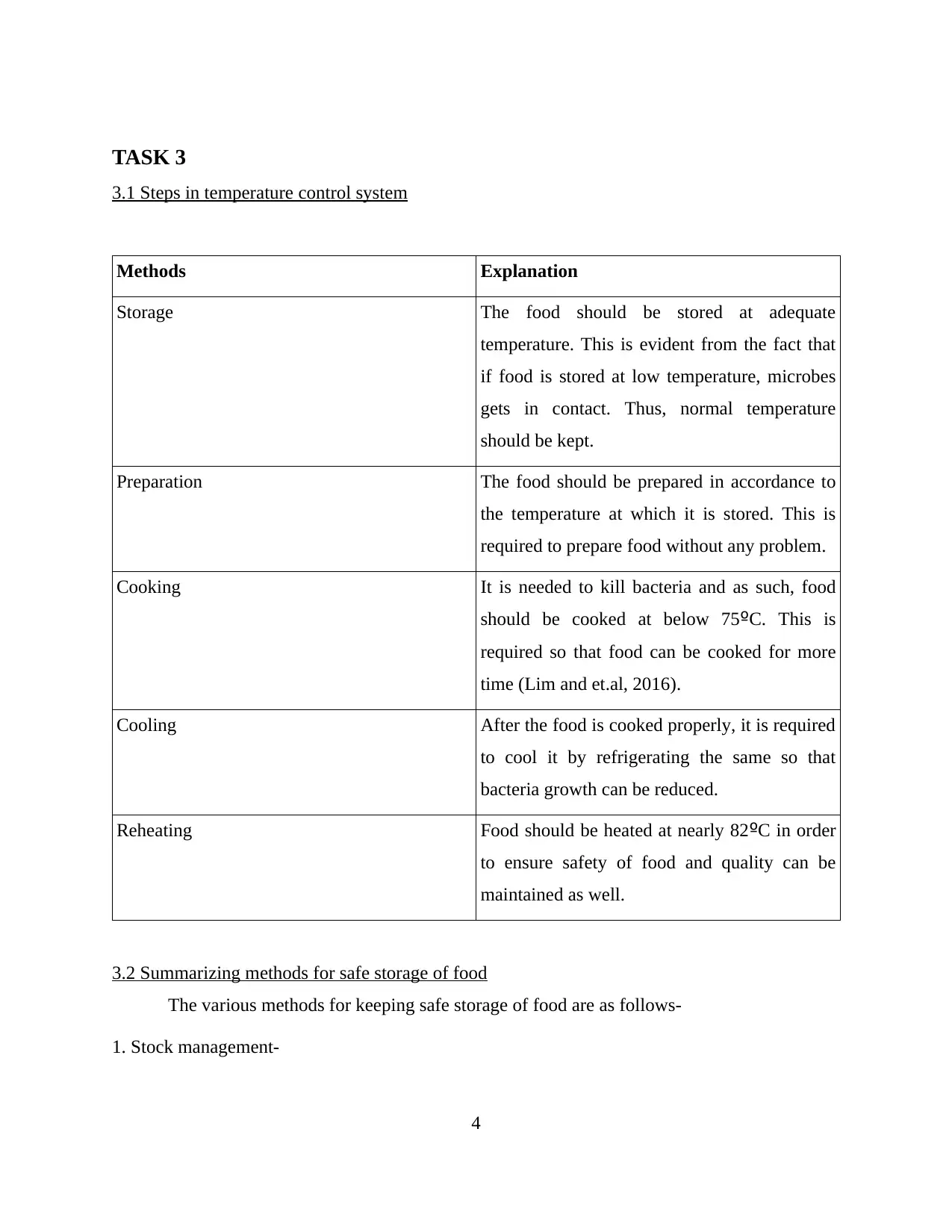
TASK 3
3.1 Steps in temperature control system
Methods Explanation
Storage The food should be stored at adequate
temperature. This is evident from the fact that
if food is stored at low temperature, microbes
gets in contact. Thus, normal temperature
should be kept.
Preparation The food should be prepared in accordance to
the temperature at which it is stored. This is
required to prepare food without any problem.
Cooking It is needed to kill bacteria and as such, food
should be cooked at below 75ºC. This is
required so that food can be cooked for more
time (Lim and et.al, 2016).
Cooling After the food is cooked properly, it is required
to cool it by refrigerating the same so that
bacteria growth can be reduced.
Reheating Food should be heated at nearly 82ºC in order
to ensure safety of food and quality can be
maintained as well.
3.2 Summarizing methods for safe storage of food
The various methods for keeping safe storage of food are as follows-
1. Stock management-
4
3.1 Steps in temperature control system
Methods Explanation
Storage The food should be stored at adequate
temperature. This is evident from the fact that
if food is stored at low temperature, microbes
gets in contact. Thus, normal temperature
should be kept.
Preparation The food should be prepared in accordance to
the temperature at which it is stored. This is
required to prepare food without any problem.
Cooking It is needed to kill bacteria and as such, food
should be cooked at below 75ºC. This is
required so that food can be cooked for more
time (Lim and et.al, 2016).
Cooling After the food is cooked properly, it is required
to cool it by refrigerating the same so that
bacteria growth can be reduced.
Reheating Food should be heated at nearly 82ºC in order
to ensure safety of food and quality can be
maintained as well.
3.2 Summarizing methods for safe storage of food
The various methods for keeping safe storage of food are as follows-
1. Stock management-
4
⊘ This is a preview!⊘
Do you want full access?
Subscribe today to unlock all pages.

Trusted by 1+ million students worldwide
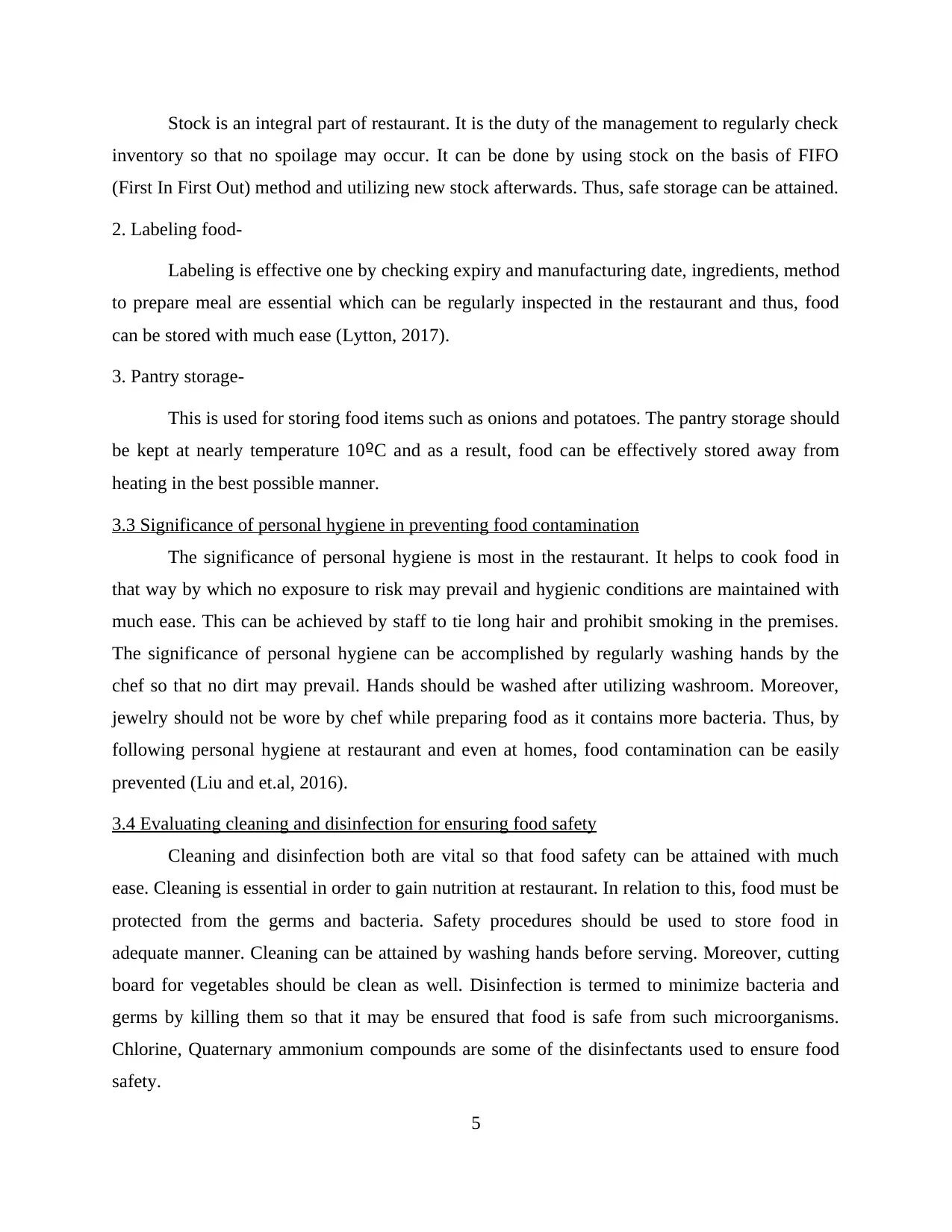
Stock is an integral part of restaurant. It is the duty of the management to regularly check
inventory so that no spoilage may occur. It can be done by using stock on the basis of FIFO
(First In First Out) method and utilizing new stock afterwards. Thus, safe storage can be attained.
2. Labeling food-
Labeling is effective one by checking expiry and manufacturing date, ingredients, method
to prepare meal are essential which can be regularly inspected in the restaurant and thus, food
can be stored with much ease (Lytton, 2017).
3. Pantry storage-
This is used for storing food items such as onions and potatoes. The pantry storage should
be kept at nearly temperature 10ºC and as a result, food can be effectively stored away from
heating in the best possible manner.
3.3 Significance of personal hygiene in preventing food contamination
The significance of personal hygiene is most in the restaurant. It helps to cook food in
that way by which no exposure to risk may prevail and hygienic conditions are maintained with
much ease. This can be achieved by staff to tie long hair and prohibit smoking in the premises.
The significance of personal hygiene can be accomplished by regularly washing hands by the
chef so that no dirt may prevail. Hands should be washed after utilizing washroom. Moreover,
jewelry should not be wore by chef while preparing food as it contains more bacteria. Thus, by
following personal hygiene at restaurant and even at homes, food contamination can be easily
prevented (Liu and et.al, 2016).
3.4 Evaluating cleaning and disinfection for ensuring food safety
Cleaning and disinfection both are vital so that food safety can be attained with much
ease. Cleaning is essential in order to gain nutrition at restaurant. In relation to this, food must be
protected from the germs and bacteria. Safety procedures should be used to store food in
adequate manner. Cleaning can be attained by washing hands before serving. Moreover, cutting
board for vegetables should be clean as well. Disinfection is termed to minimize bacteria and
germs by killing them so that it may be ensured that food is safe from such microorganisms.
Chlorine, Quaternary ammonium compounds are some of the disinfectants used to ensure food
safety.
5
inventory so that no spoilage may occur. It can be done by using stock on the basis of FIFO
(First In First Out) method and utilizing new stock afterwards. Thus, safe storage can be attained.
2. Labeling food-
Labeling is effective one by checking expiry and manufacturing date, ingredients, method
to prepare meal are essential which can be regularly inspected in the restaurant and thus, food
can be stored with much ease (Lytton, 2017).
3. Pantry storage-
This is used for storing food items such as onions and potatoes. The pantry storage should
be kept at nearly temperature 10ºC and as a result, food can be effectively stored away from
heating in the best possible manner.
3.3 Significance of personal hygiene in preventing food contamination
The significance of personal hygiene is most in the restaurant. It helps to cook food in
that way by which no exposure to risk may prevail and hygienic conditions are maintained with
much ease. This can be achieved by staff to tie long hair and prohibit smoking in the premises.
The significance of personal hygiene can be accomplished by regularly washing hands by the
chef so that no dirt may prevail. Hands should be washed after utilizing washroom. Moreover,
jewelry should not be wore by chef while preparing food as it contains more bacteria. Thus, by
following personal hygiene at restaurant and even at homes, food contamination can be easily
prevented (Liu and et.al, 2016).
3.4 Evaluating cleaning and disinfection for ensuring food safety
Cleaning and disinfection both are vital so that food safety can be attained with much
ease. Cleaning is essential in order to gain nutrition at restaurant. In relation to this, food must be
protected from the germs and bacteria. Safety procedures should be used to store food in
adequate manner. Cleaning can be attained by washing hands before serving. Moreover, cutting
board for vegetables should be clean as well. Disinfection is termed to minimize bacteria and
germs by killing them so that it may be ensured that food is safe from such microorganisms.
Chlorine, Quaternary ammonium compounds are some of the disinfectants used to ensure food
safety.
5
Paraphrase This Document
Need a fresh take? Get an instant paraphrase of this document with our AI Paraphraser
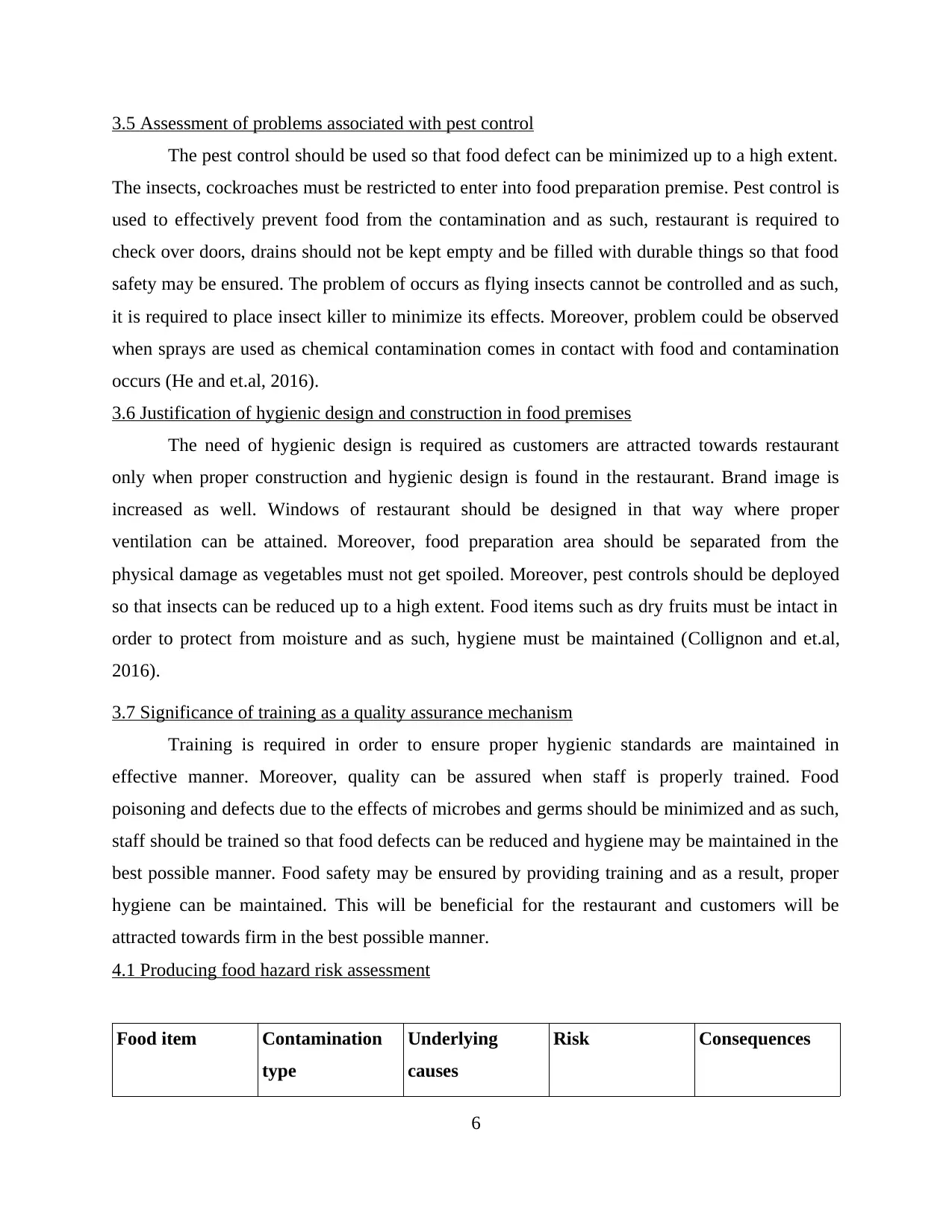
3.5 Assessment of problems associated with pest control
The pest control should be used so that food defect can be minimized up to a high extent.
The insects, cockroaches must be restricted to enter into food preparation premise. Pest control is
used to effectively prevent food from the contamination and as such, restaurant is required to
check over doors, drains should not be kept empty and be filled with durable things so that food
safety may be ensured. The problem of occurs as flying insects cannot be controlled and as such,
it is required to place insect killer to minimize its effects. Moreover, problem could be observed
when sprays are used as chemical contamination comes in contact with food and contamination
occurs (He and et.al, 2016).
3.6 Justification of hygienic design and construction in food premises
The need of hygienic design is required as customers are attracted towards restaurant
only when proper construction and hygienic design is found in the restaurant. Brand image is
increased as well. Windows of restaurant should be designed in that way where proper
ventilation can be attained. Moreover, food preparation area should be separated from the
physical damage as vegetables must not get spoiled. Moreover, pest controls should be deployed
so that insects can be reduced up to a high extent. Food items such as dry fruits must be intact in
order to protect from moisture and as such, hygiene must be maintained (Collignon and et.al,
2016).
3.7 Significance of training as a quality assurance mechanism
Training is required in order to ensure proper hygienic standards are maintained in
effective manner. Moreover, quality can be assured when staff is properly trained. Food
poisoning and defects due to the effects of microbes and germs should be minimized and as such,
staff should be trained so that food defects can be reduced and hygiene may be maintained in the
best possible manner. Food safety may be ensured by providing training and as a result, proper
hygiene can be maintained. This will be beneficial for the restaurant and customers will be
attracted towards firm in the best possible manner.
4.1 Producing food hazard risk assessment
Food item Contamination
type
Underlying
causes
Risk Consequences
6
The pest control should be used so that food defect can be minimized up to a high extent.
The insects, cockroaches must be restricted to enter into food preparation premise. Pest control is
used to effectively prevent food from the contamination and as such, restaurant is required to
check over doors, drains should not be kept empty and be filled with durable things so that food
safety may be ensured. The problem of occurs as flying insects cannot be controlled and as such,
it is required to place insect killer to minimize its effects. Moreover, problem could be observed
when sprays are used as chemical contamination comes in contact with food and contamination
occurs (He and et.al, 2016).
3.6 Justification of hygienic design and construction in food premises
The need of hygienic design is required as customers are attracted towards restaurant
only when proper construction and hygienic design is found in the restaurant. Brand image is
increased as well. Windows of restaurant should be designed in that way where proper
ventilation can be attained. Moreover, food preparation area should be separated from the
physical damage as vegetables must not get spoiled. Moreover, pest controls should be deployed
so that insects can be reduced up to a high extent. Food items such as dry fruits must be intact in
order to protect from moisture and as such, hygiene must be maintained (Collignon and et.al,
2016).
3.7 Significance of training as a quality assurance mechanism
Training is required in order to ensure proper hygienic standards are maintained in
effective manner. Moreover, quality can be assured when staff is properly trained. Food
poisoning and defects due to the effects of microbes and germs should be minimized and as such,
staff should be trained so that food defects can be reduced and hygiene may be maintained in the
best possible manner. Food safety may be ensured by providing training and as a result, proper
hygiene can be maintained. This will be beneficial for the restaurant and customers will be
attracted towards firm in the best possible manner.
4.1 Producing food hazard risk assessment
Food item Contamination
type
Underlying
causes
Risk Consequences
6
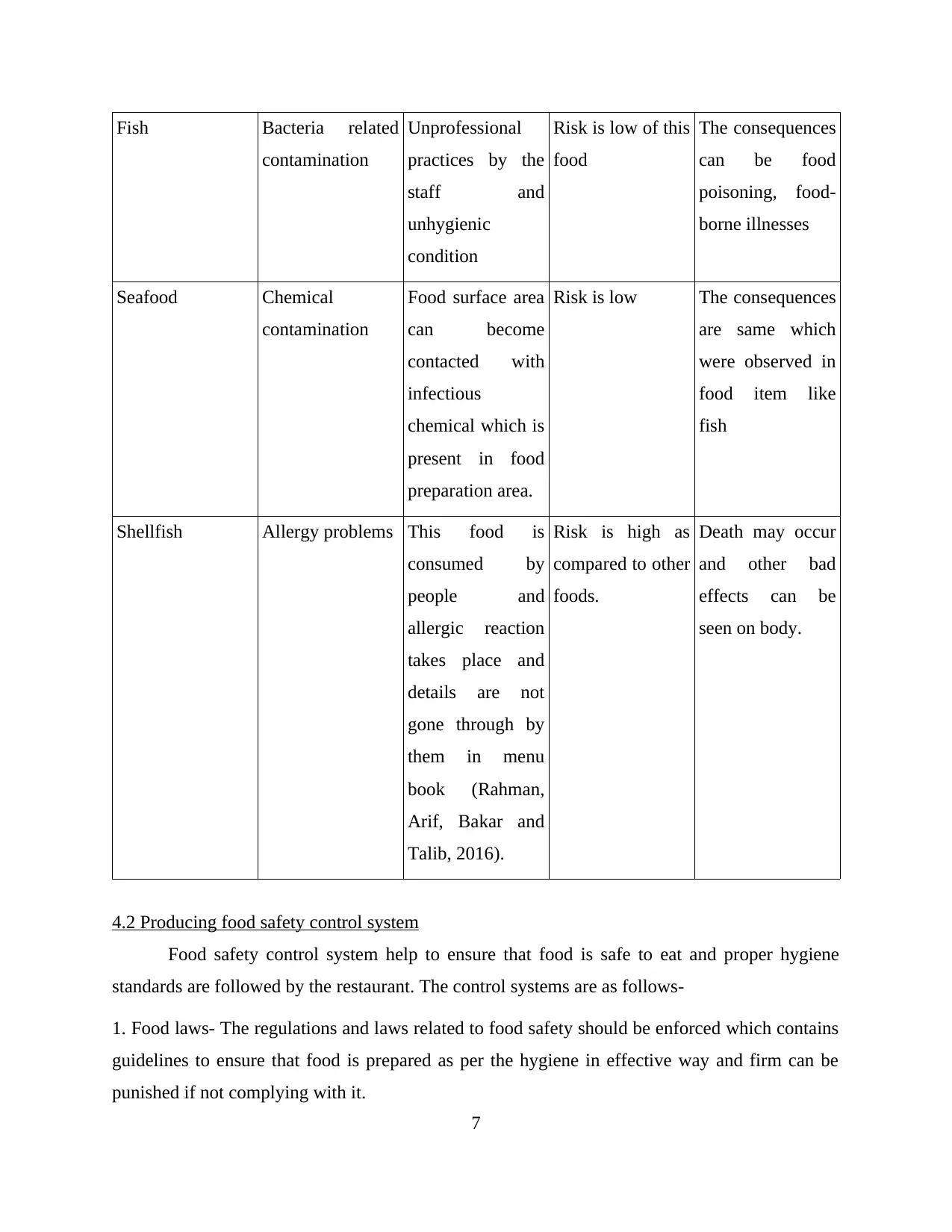
Fish Bacteria related
contamination
Unprofessional
practices by the
staff and
unhygienic
condition
Risk is low of this
food
The consequences
can be food
poisoning, food-
borne illnesses
Seafood Chemical
contamination
Food surface area
can become
contacted with
infectious
chemical which is
present in food
preparation area.
Risk is low The consequences
are same which
were observed in
food item like
fish
Shellfish Allergy problems This food is
consumed by
people and
allergic reaction
takes place and
details are not
gone through by
them in menu
book (Rahman,
Arif, Bakar and
Talib, 2016).
Risk is high as
compared to other
foods.
Death may occur
and other bad
effects can be
seen on body.
4.2 Producing food safety control system
Food safety control system help to ensure that food is safe to eat and proper hygiene
standards are followed by the restaurant. The control systems are as follows-
1. Food laws- The regulations and laws related to food safety should be enforced which contains
guidelines to ensure that food is prepared as per the hygiene in effective way and firm can be
punished if not complying with it.
7
contamination
Unprofessional
practices by the
staff and
unhygienic
condition
Risk is low of this
food
The consequences
can be food
poisoning, food-
borne illnesses
Seafood Chemical
contamination
Food surface area
can become
contacted with
infectious
chemical which is
present in food
preparation area.
Risk is low The consequences
are same which
were observed in
food item like
fish
Shellfish Allergy problems This food is
consumed by
people and
allergic reaction
takes place and
details are not
gone through by
them in menu
book (Rahman,
Arif, Bakar and
Talib, 2016).
Risk is high as
compared to other
foods.
Death may occur
and other bad
effects can be
seen on body.
4.2 Producing food safety control system
Food safety control system help to ensure that food is safe to eat and proper hygiene
standards are followed by the restaurant. The control systems are as follows-
1. Food laws- The regulations and laws related to food safety should be enforced which contains
guidelines to ensure that food is prepared as per the hygiene in effective way and firm can be
punished if not complying with it.
7
⊘ This is a preview!⊘
Do you want full access?
Subscribe today to unlock all pages.

Trusted by 1+ million students worldwide
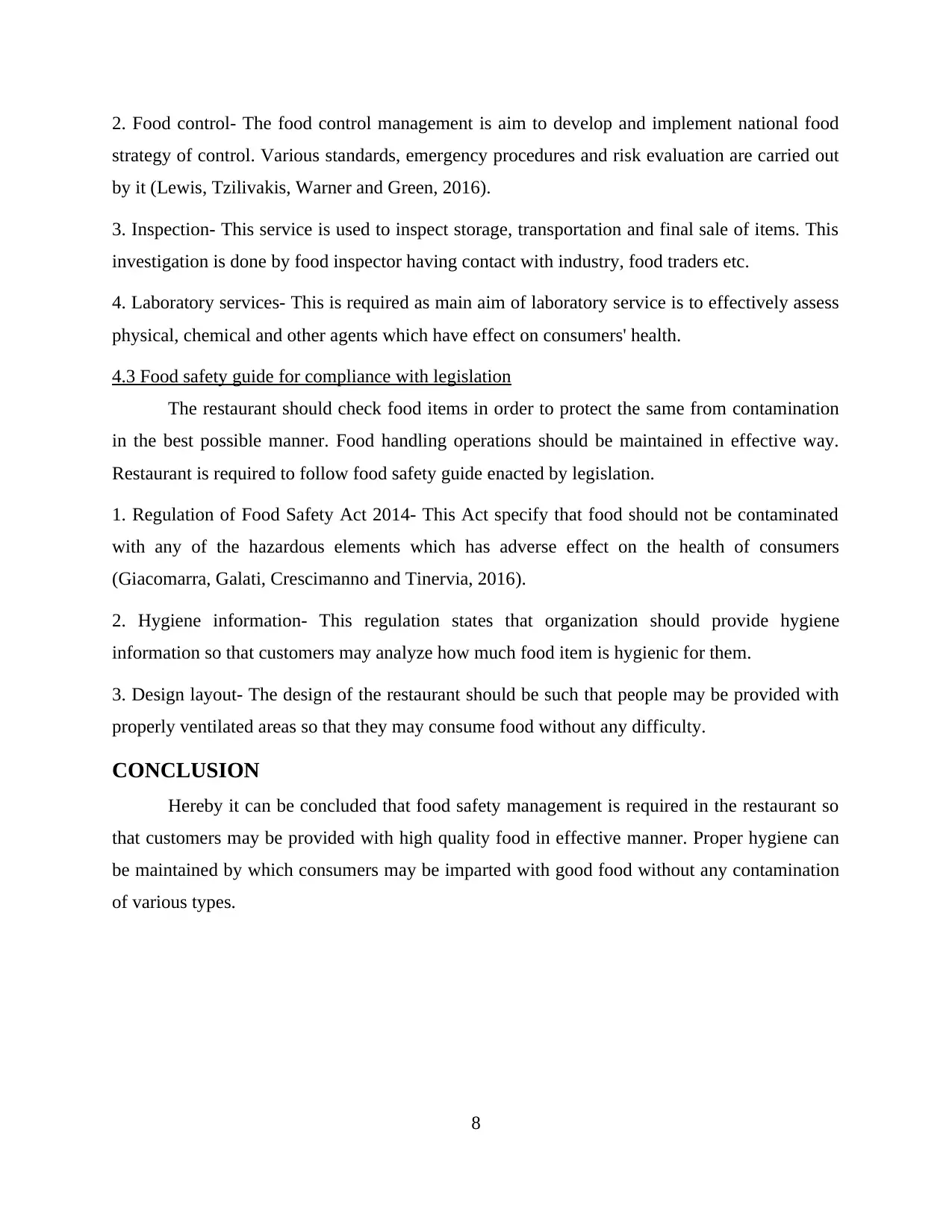
2. Food control- The food control management is aim to develop and implement national food
strategy of control. Various standards, emergency procedures and risk evaluation are carried out
by it (Lewis, Tzilivakis, Warner and Green, 2016).
3. Inspection- This service is used to inspect storage, transportation and final sale of items. This
investigation is done by food inspector having contact with industry, food traders etc.
4. Laboratory services- This is required as main aim of laboratory service is to effectively assess
physical, chemical and other agents which have effect on consumers' health.
4.3 Food safety guide for compliance with legislation
The restaurant should check food items in order to protect the same from contamination
in the best possible manner. Food handling operations should be maintained in effective way.
Restaurant is required to follow food safety guide enacted by legislation.
1. Regulation of Food Safety Act 2014- This Act specify that food should not be contaminated
with any of the hazardous elements which has adverse effect on the health of consumers
(Giacomarra, Galati, Crescimanno and Tinervia, 2016).
2. Hygiene information- This regulation states that organization should provide hygiene
information so that customers may analyze how much food item is hygienic for them.
3. Design layout- The design of the restaurant should be such that people may be provided with
properly ventilated areas so that they may consume food without any difficulty.
CONCLUSION
Hereby it can be concluded that food safety management is required in the restaurant so
that customers may be provided with high quality food in effective manner. Proper hygiene can
be maintained by which consumers may be imparted with good food without any contamination
of various types.
8
strategy of control. Various standards, emergency procedures and risk evaluation are carried out
by it (Lewis, Tzilivakis, Warner and Green, 2016).
3. Inspection- This service is used to inspect storage, transportation and final sale of items. This
investigation is done by food inspector having contact with industry, food traders etc.
4. Laboratory services- This is required as main aim of laboratory service is to effectively assess
physical, chemical and other agents which have effect on consumers' health.
4.3 Food safety guide for compliance with legislation
The restaurant should check food items in order to protect the same from contamination
in the best possible manner. Food handling operations should be maintained in effective way.
Restaurant is required to follow food safety guide enacted by legislation.
1. Regulation of Food Safety Act 2014- This Act specify that food should not be contaminated
with any of the hazardous elements which has adverse effect on the health of consumers
(Giacomarra, Galati, Crescimanno and Tinervia, 2016).
2. Hygiene information- This regulation states that organization should provide hygiene
information so that customers may analyze how much food item is hygienic for them.
3. Design layout- The design of the restaurant should be such that people may be provided with
properly ventilated areas so that they may consume food without any difficulty.
CONCLUSION
Hereby it can be concluded that food safety management is required in the restaurant so
that customers may be provided with high quality food in effective manner. Proper hygiene can
be maintained by which consumers may be imparted with good food without any contamination
of various types.
8
Paraphrase This Document
Need a fresh take? Get an instant paraphrase of this document with our AI Paraphraser
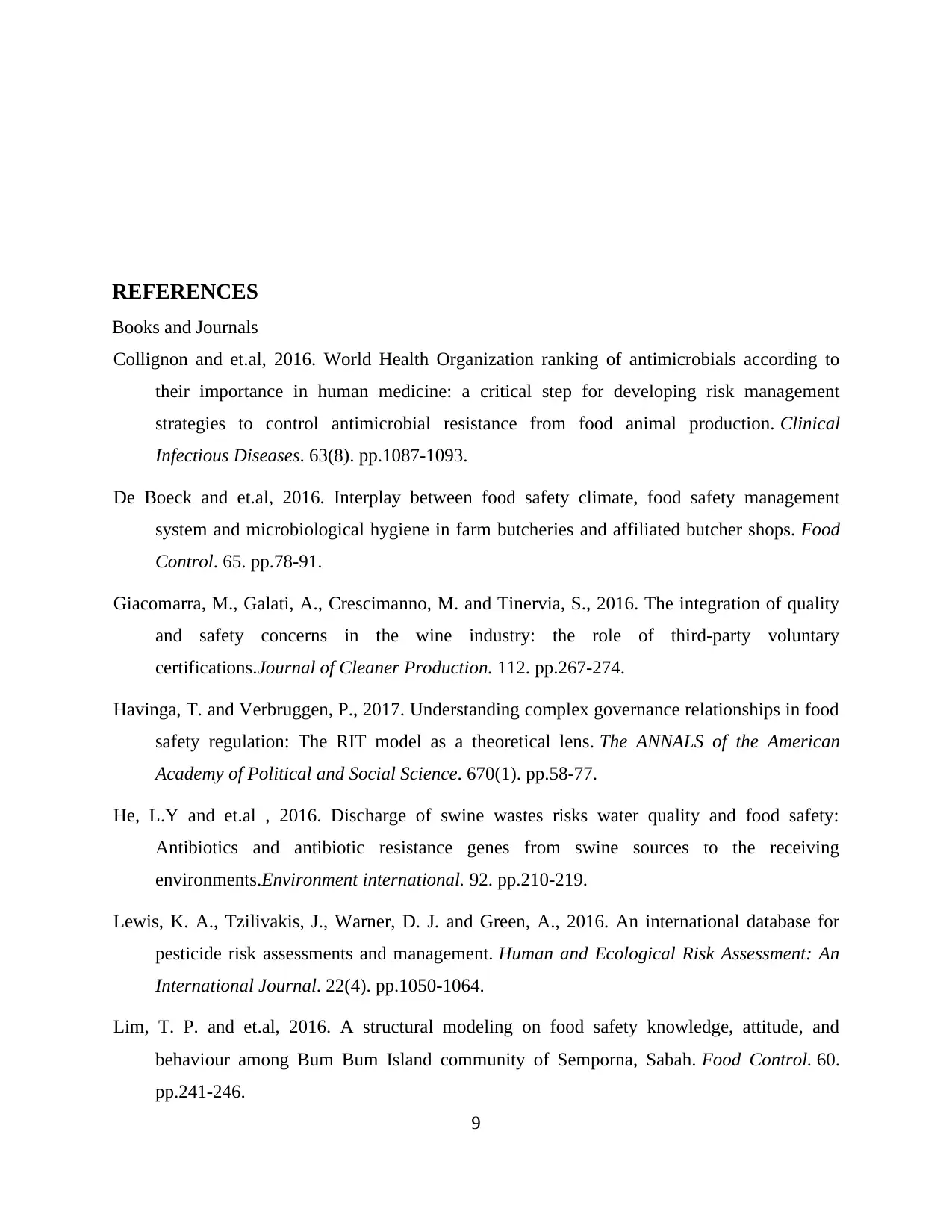
REFERENCES
Books and Journals
Collignon and et.al, 2016. World Health Organization ranking of antimicrobials according to
their importance in human medicine: a critical step for developing risk management
strategies to control antimicrobial resistance from food animal production. Clinical
Infectious Diseases. 63(8). pp.1087-1093.
De Boeck and et.al, 2016. Interplay between food safety climate, food safety management
system and microbiological hygiene in farm butcheries and affiliated butcher shops. Food
Control. 65. pp.78-91.
Giacomarra, M., Galati, A., Crescimanno, M. and Tinervia, S., 2016. The integration of quality
and safety concerns in the wine industry: the role of third-party voluntary
certifications.Journal of Cleaner Production. 112. pp.267-274.
Havinga, T. and Verbruggen, P., 2017. Understanding complex governance relationships in food
safety regulation: The RIT model as a theoretical lens. The ANNALS of the American
Academy of Political and Social Science. 670(1). pp.58-77.
He, L.Y and et.al , 2016. Discharge of swine wastes risks water quality and food safety:
Antibiotics and antibiotic resistance genes from swine sources to the receiving
environments.Environment international. 92. pp.210-219.
Lewis, K. A., Tzilivakis, J., Warner, D. J. and Green, A., 2016. An international database for
pesticide risk assessments and management. Human and Ecological Risk Assessment: An
International Journal. 22(4). pp.1050-1064.
Lim, T. P. and et.al, 2016. A structural modeling on food safety knowledge, attitude, and
behaviour among Bum Bum Island community of Semporna, Sabah. Food Control. 60.
pp.241-246.
9
Books and Journals
Collignon and et.al, 2016. World Health Organization ranking of antimicrobials according to
their importance in human medicine: a critical step for developing risk management
strategies to control antimicrobial resistance from food animal production. Clinical
Infectious Diseases. 63(8). pp.1087-1093.
De Boeck and et.al, 2016. Interplay between food safety climate, food safety management
system and microbiological hygiene in farm butcheries and affiliated butcher shops. Food
Control. 65. pp.78-91.
Giacomarra, M., Galati, A., Crescimanno, M. and Tinervia, S., 2016. The integration of quality
and safety concerns in the wine industry: the role of third-party voluntary
certifications.Journal of Cleaner Production. 112. pp.267-274.
Havinga, T. and Verbruggen, P., 2017. Understanding complex governance relationships in food
safety regulation: The RIT model as a theoretical lens. The ANNALS of the American
Academy of Political and Social Science. 670(1). pp.58-77.
He, L.Y and et.al , 2016. Discharge of swine wastes risks water quality and food safety:
Antibiotics and antibiotic resistance genes from swine sources to the receiving
environments.Environment international. 92. pp.210-219.
Lewis, K. A., Tzilivakis, J., Warner, D. J. and Green, A., 2016. An international database for
pesticide risk assessments and management. Human and Ecological Risk Assessment: An
International Journal. 22(4). pp.1050-1064.
Lim, T. P. and et.al, 2016. A structural modeling on food safety knowledge, attitude, and
behaviour among Bum Bum Island community of Semporna, Sabah. Food Control. 60.
pp.241-246.
9

Liu, Y. and et.al , 2016. An Internet-of-Things solution for food safety and quality control: A
pilot project in China. Journal of Industrial Information Integration. 3. pp.1-7.
Lytton, T. D., 2017. The taming of the stew: Regulatory intermediaries in food safety
governance. The ANNALS of the American Academy of Political and Social
Science. 670(1). pp.78-92.
Manning, L. and Soon, J. M., 2016. Food safety, food fraud, and food defense: a fast evolving
literature. Journal of food science. 81(4).
Rahman, M. M., Arif, M. T., Bakar, K. and bt Talib, Z., 2016. Food safety knowledge, attitude
and hygiene practices among the street food vendors in Northern Kuching city,
Sarawak.Borneo Science. 31.
Online
Causes and prevention of foodborne illness. 2018 [Online] Available Through:
<https://web.uri.edu/foodsafety/cause-and-prevention-of-foodborne-illness/>
10
pilot project in China. Journal of Industrial Information Integration. 3. pp.1-7.
Lytton, T. D., 2017. The taming of the stew: Regulatory intermediaries in food safety
governance. The ANNALS of the American Academy of Political and Social
Science. 670(1). pp.78-92.
Manning, L. and Soon, J. M., 2016. Food safety, food fraud, and food defense: a fast evolving
literature. Journal of food science. 81(4).
Rahman, M. M., Arif, M. T., Bakar, K. and bt Talib, Z., 2016. Food safety knowledge, attitude
and hygiene practices among the street food vendors in Northern Kuching city,
Sarawak.Borneo Science. 31.
Online
Causes and prevention of foodborne illness. 2018 [Online] Available Through:
<https://web.uri.edu/foodsafety/cause-and-prevention-of-foodborne-illness/>
10
⊘ This is a preview!⊘
Do you want full access?
Subscribe today to unlock all pages.

Trusted by 1+ million students worldwide
1 out of 12
Related Documents
Your All-in-One AI-Powered Toolkit for Academic Success.
+13062052269
info@desklib.com
Available 24*7 on WhatsApp / Email
![[object Object]](/_next/static/media/star-bottom.7253800d.svg)
Unlock your academic potential
Copyright © 2020–2025 A2Z Services. All Rights Reserved. Developed and managed by ZUCOL.





